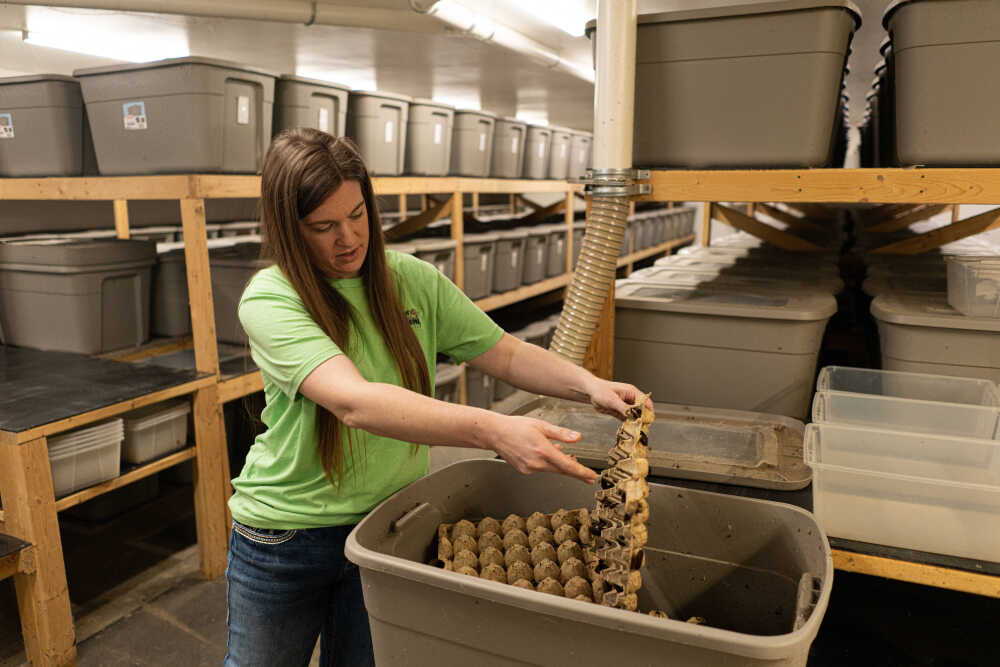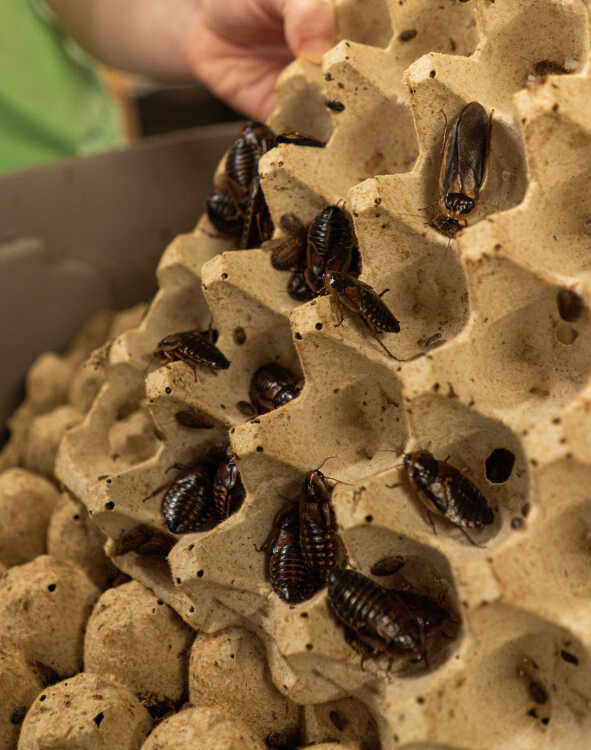
Graycie, a bearded dragon, snatches a medium-sized dubia cockroach from the finger of Amber Kimbrell, of Kimbrell's Coldblood, Inc. In addition to selling cockroaches to reptile food suppliers, the Kimbrells are working with Southeast Missouri State University students to develop a strategy for selling the cockroaches' manure as natural pesticides.
Photo by Aaron Eisenhauer
Quentin Kimbrell is in the cockroach business. In the morning, he turns the lights on at his facility, and even on the sunniest days, he hears rain. The rain is not the sound of water hitting the roof: It is the sound of more than 300,000 cockroaches scattering inside plastic bins.
Quentin’s business, Kimbrell’s Coldblood Inc. in Jackson, sells blaptica dubia roaches to reptile food retailers across the country — except in Florida, where dubia roaches are illegal since the South American species may become invasive in the humid climate. But here in Southeast Missouri, and throughout most of the United States, dubia roaches are not pests or threats. They are a way to keep pet reptiles happy, healthy and fed.
Popular pet reptiles such as the bearded dragon, leopard gecko and panther chameleon are all consumers of insects — specifically crickets and dubia roaches. Years ago, Quentin wanted to cut his food cost down for feeding his pet bearded dragons. So, instead of constantly buying crickets, he started breeding dubia roaches. He says they are the more nutritious and protein-packed food alternative to crickets; they are also safer to keep in a container with the reptile.
“[Dubia roaches] can’t bite. They can’t sting. … Crickets can actually eat through that [reptile’s] skin and cause a sore on them,” Quentin says. “These do not have the mouthparts to do that. They’re not going to harm the reptile if some of them are left overnight [in the reptile’s enclosure].”

Amber Kimbrell, of Kimbrell's Coldblood Inc., holds a female dubia cockroach that is carrying an egg sac at the back of its abdomen. One female dubia roach has approximately 15 to 20 babies every eight weeks.
Photo by Aaron Eisenhauer
Quentin started his business with a few tubs of roaches in his basement. Demand grew fast, and soon, he was making more money selling roaches than at his day job working for a pallet company, so he quit and pursued his roach breeding business full-time. He built his first facility in Illinois and then moved to Jackson, his wife Amber Kimbrell’s hometown, where he built the current Kimbrell’s Coldblood Inc. facility.
Even in the middle of January, it is warm inside Kimbrell’s Coldblood Inc., with temperatures ranging between 80 and 90 degrees Fahrenheit. Rows of gray, five-gallon plastic tubs sit on tidy shelves, labeled by stripes of color denoting the size of cockroach each contains — extra small, small, medium or large. The exact temperature of each roach colony is regulated using wired heat tape Quentin installed himself.
Quentin says he has approximately 360 tubs full of cockroaches in this one room. In the attached breeding room next door, there are more tubs containing even more cockroaches. It is an extremely organized, clean and functional space.
“I always like asking people what they expected,” Amber says. “A lot of people are like, ‘I just expected they’d be crawling up the walls.’”
Roaches are not crawling up any walls, but they are crawling. Quentin opens up a bin and removes a handful of egg crates used as “extra surface area” for roaches to crawl and climb on. Amber calls them “roach condos.”
Exposed to the light now, the roaches instantly scatter and run to the container’s corners. They crawl and burrow under each other in a shifting brown mass. They hide beneath each other, fighting for the darkest patch of space in a pile of themselves. Quentin says this happens because they are nocturnal creatures, most active in the darkness. It is the reason there are no windows in his facility.

Amber Kimbrell lifts pieces of paper egg crate as she looks over the dubia cockroaches at the business's facility in Jackson. The Kimbrells have approximately 360 tubs full of dubia cockroaches at their business in Jackson.
Photo by Aaron Eisenhauer
Quentin and Amber know a lot about the “misunderstood” species of cockroach. For example, dubia cockroaches are not super-adept climbers or fliers, even though adult males have full wings and adult females have wing stubs. The males can only “flutterfall,” or move across a space, never gaining altitude. Quentin says they are also not the “home-infesting” cockroaches people think of, either. That is a different species entirely: the German cockroach.
“Cockroaches get such a bad rap,” Quentin says. “They’re really good for nature. They’re just like a lot of insects people don’t like, but they’re so beneficial for nature. They break stuff down.”
Amber says, “They’re also cute.” She grabs an older female and points out all of the features of the insect, the six legs with tiny spikes, the brown butterfly-shaped stubs on her back and the little face with small, beady eyes. No one pays attention to their faces, Amber says.
Quentin’s work starts with breeding cockroaches in plastic bins. He says one female has approximately 15 to 20 babies every eight weeks. The gravid, otherwise known as pregnant, cockroach carries her egg sac outside of the body after 50 days, regulating the temperature of the eggs by pulling them closer to or further from her body; she can also abort her eggs if she feels threatened.

Dubia cockroaches climb over a paper egg crate, a medium that gives them plenty of surface area and cover. Nocturnal creatures, the cockroaches fight for the darkest places to be.
Photo by Aaron Eisenhauer
Once born, it takes a dubia roach approximately six months to reach adulthood. Quentin says the dubia roaches molt seven times between infancy and adulthood. Molting is how cockroaches grow: Their old shells split open to reveal a soft, white body and weak appendages. They remain this ghost-like pallor for 24 hours as their new bodies harden and darken in color. This is the most vulnerable time for a cockroach, because if other cockroaches become dehydrated, they may eat the molting cockroaches for moisture.
Amber says when she was dating Quentin, she’d set up a “hospital” for the soft, molting cockroaches, so they could have a few hours to harden away from the others. Quentin jokes he isn’t that nice.
To be successful at roach raising, it’s important to understand the insects’ behavior. Quentin says they weigh and sort the roaches by sex to ensure there is a certain ratio of male to female roaches. If there are too many males, they will fight and kill each other off, and there won’t be any males left to sustain the colony. He says this process takes weeks. Then, after he sorts by size, he can sell the different sizes to resellers.
Quentin keeps his roach colonies fed with “roach chow,” a sawdust-like food created from plants, and hydrated with water crystals, a gel-like polymer commonly used in floral arrangements. This form of water prevents the roaches from drowning.
Nothing is wasted at Kimbrell’s Coldblood Inc. Naturally-occurring dermacide beetles act as a “clean-up” crew, eating the dead roaches and keeping bins clean. The frass, or insect manure, is collected and stored in a building next door. Right now, Quentin has two years worth of frass in a massive pile resembling dry, grayish dirt. It has no smell. Currently, he is working with Southeast Missouri State University students to develop a strategy to package and sell this frass for profit, since it acts as a natural pesticide, due to the presence of the insect protein chitin.
“Any time an insect is around a plant, that plant says, ‘Hey, I’m under attack,’ ‘cause [the insect] has that protein, chitin, around it, and [the plant] starts going into defense mode. … [The plant] may produce more enzymes or foliage to get stronger,” Quentin says.
The potential of insect manure is promising, but Quentin says his main focus is selling cockroaches to feed beloved reptiles like the Kimbrells’ bearded dragon, Graycie.
The dubia cockroaches are fairly indestructible. When Quentin ships them out to customers, he sends them without food or water, because after all, “They are cockroaches.” Once, he says, a package of his roaches got rerouted multiple times and lost in the mail for 21 days during a brutally hot summer, and still, 95% of the insects survived. They are fighters, quite literally. They fight each other, and they fight to live, by whatever means necessary.
But when placed near the Kimbrells’ bearded dragon Graycie’s mouth, the cockroach is no longer indestructible. Graycie’s long, pink tongue latches onto its shell, and in a second, the cockroach is gone. The cockroach is energy now. Nature has served its purpose.
 Local News 4/19/24Inside Becca’s Closet: A mission to dress teens for formal eventsThe organization Becca’s Closet, which helps young girls get access to formal dresses for dances and proms, is celebrating its 20th anniversary this year. Cape Girardeau is the home to one of two Missouri chapters, and one of 51 in the U.S...
Local News 4/19/24Inside Becca’s Closet: A mission to dress teens for formal eventsThe organization Becca’s Closet, which helps young girls get access to formal dresses for dances and proms, is celebrating its 20th anniversary this year. Cape Girardeau is the home to one of two Missouri chapters, and one of 51 in the U.S... Local News 4/19/24Southeast Missouri State University's symphony conductor Sara Edgerton to retire1Sara Edgerton, professor of cello and string bass and artistic director and conductor of the Southeast Missouri Symphony Orchestra at Southeast Missouri State University, is set to retire after 33 years...
Local News 4/19/24Southeast Missouri State University's symphony conductor Sara Edgerton to retire1Sara Edgerton, professor of cello and string bass and artistic director and conductor of the Southeast Missouri Symphony Orchestra at Southeast Missouri State University, is set to retire after 33 years...






 Local News 4/18/24Catholic Charities to hold ribbon-cutting for LifeHouse grand openingLifeHouse Crisis Maternity Home will provide education and support to pregnant women and new mothers at risk of homelessness. After 15 months of construction, the first resident will move in at the end of April. ...
Local News 4/18/24Catholic Charities to hold ribbon-cutting for LifeHouse grand openingLifeHouse Crisis Maternity Home will provide education and support to pregnant women and new mothers at risk of homelessness. After 15 months of construction, the first resident will move in at the end of April. ... Local News 4/18/24Tenmile looks to add balcony to old Esquire Theater building2Cape Girardeau City Council approved a license and indemnity agreement with Tenmile Holdings LLC on Monday, April 15, for the installation of a marquee sign and awning with column posts for the old Esquire Theater building. ...
Local News 4/18/24Tenmile looks to add balcony to old Esquire Theater building2Cape Girardeau City Council approved a license and indemnity agreement with Tenmile Holdings LLC on Monday, April 15, for the installation of a marquee sign and awning with column posts for the old Esquire Theater building. ... Local News 4/18/24SEMO Orchestra to perform Elgar, Dvorak next week at River CampusThe Southeast Missouri State University Orchestra and guest cellist Julian Schwarz will present a two-piece program Tuesday, April 23, at the River Campus in Cape Girardeau. The concert will begin at 7:30 p.m. in Bedell Performance Hall, 518 S....
Local News 4/18/24SEMO Orchestra to perform Elgar, Dvorak next week at River CampusThe Southeast Missouri State University Orchestra and guest cellist Julian Schwarz will present a two-piece program Tuesday, April 23, at the River Campus in Cape Girardeau. The concert will begin at 7:30 p.m. in Bedell Performance Hall, 518 S.... Local News 4/18/24Police: Bollinger County woman told elaborate lies across multiple investigations, including sexual assault4BOLLINGER COUNTY — Police say a Bollinger County woman told several elaborate lies during sexual assault and harassment investigations in a complex and escalating scheme that targeted the mother of her fiance’s child. Michelle D. Kaempfer of Glen...
Local News 4/18/24Police: Bollinger County woman told elaborate lies across multiple investigations, including sexual assault4BOLLINGER COUNTY — Police say a Bollinger County woman told several elaborate lies during sexual assault and harassment investigations in a complex and escalating scheme that targeted the mother of her fiance’s child. Michelle D. Kaempfer of Glen... Local News 4/18/24Jackson police, DEA host National Prescription Drug Take Back Day1The Jackson Police Department and Drug Enforcement Administration (DEA) will team up to host DEA’s National Prescription Drug Take Back Day on Saturday, April 27. The two organizations will collect different forms of prescription drugs. The...
Local News 4/18/24Jackson police, DEA host National Prescription Drug Take Back Day1The Jackson Police Department and Drug Enforcement Administration (DEA) will team up to host DEA’s National Prescription Drug Take Back Day on Saturday, April 27. The two organizations will collect different forms of prescription drugs. The...













 Most read 4/12/24Notre Dame to transition to president/principal model beginning July 17Notre Dame Regional High School announced Monday, April 8, that it will be transitioning to a president/principal model Monday, July 1. Current principal Tim Garner will assume the role of president, while assistant principal Paul Unterreiner will...
Most read 4/12/24Notre Dame to transition to president/principal model beginning July 17Notre Dame Regional High School announced Monday, April 8, that it will be transitioning to a president/principal model Monday, July 1. Current principal Tim Garner will assume the role of president, while assistant principal Paul Unterreiner will... Most read 4/12/24Coroner still hasn't found attorney as Missouri AG seeks to remove him from office13More than two months after the Missouri Attorney General's Office filed court action to remove Cape Girardeau County Coroner Wavis Jordan from office, the local officeholder has still not found an attorney to help him fight to keep his job. Wavis...
Most read 4/12/24Coroner still hasn't found attorney as Missouri AG seeks to remove him from office13More than two months after the Missouri Attorney General's Office filed court action to remove Cape Girardeau County Coroner Wavis Jordan from office, the local officeholder has still not found an attorney to help him fight to keep his job. Wavis...






